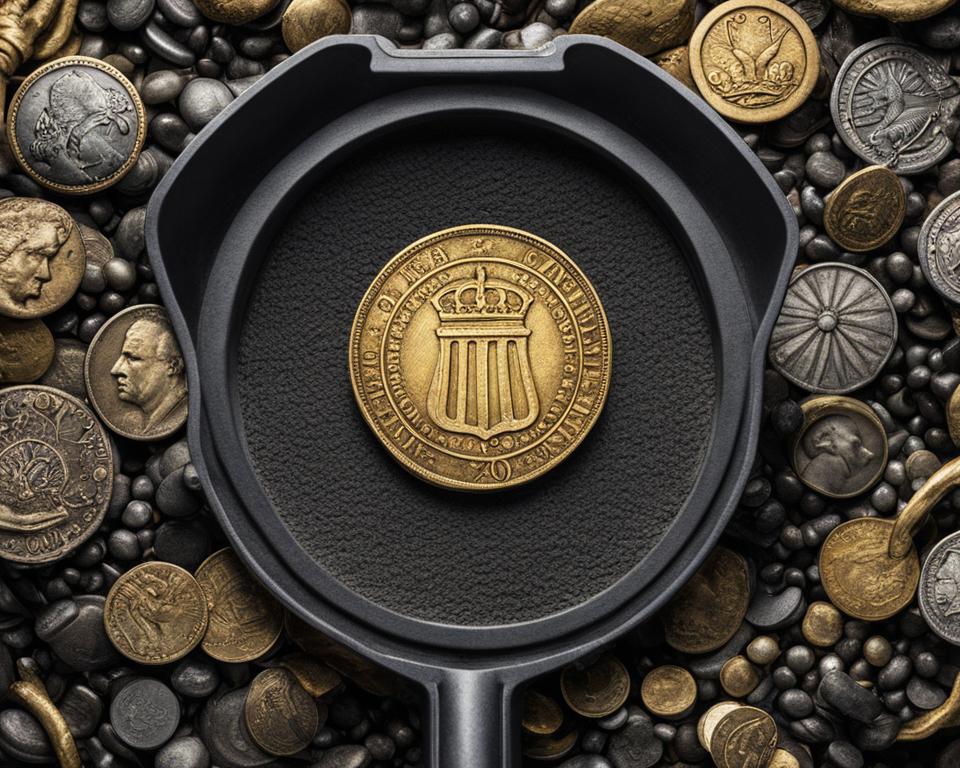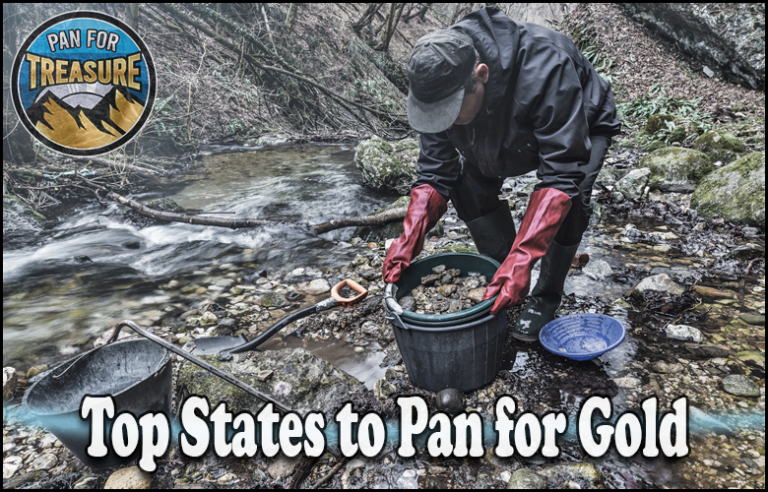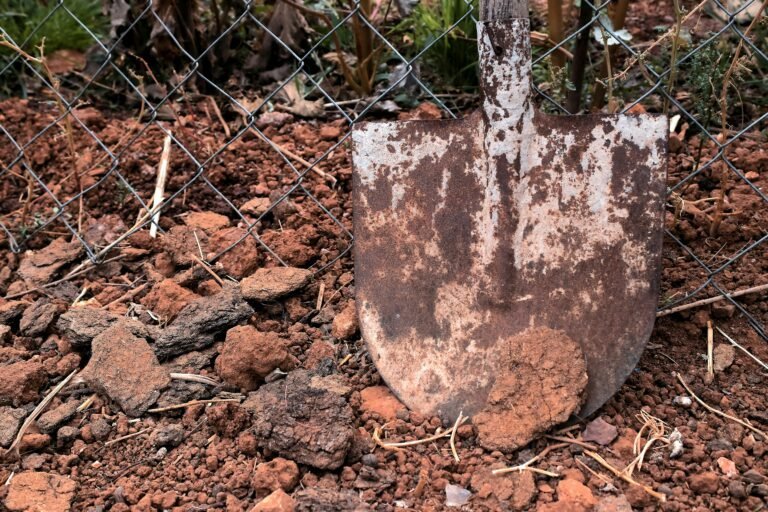Metal detecting is a popular hobby that allows enthusiasts to uncover a wide range of valuable items.
First Posted December 5, 2024 | Last Updated on July 29, 2025 by Ryan ConlonDisclosure: This Post Contains Affiliate Links; We earn a commission on purchases.
While gold may be the first thing that comes to mind, there are many other treasures waiting to be discovered with a metal detector.
From valuable collectibles to buried relics, each find holds the potential for excitement and adventure.
Key Takeaways:
- Metal detecting goes beyond searching for gold, offering the opportunity to find valuable collectibles.
- You can uncover buried treasure, lost jewelry, historical artifacts, and ancient coins with a metal detector.
- Hidden caches and relics from the past can provide a fascinating glimpse into history.
- Rare antiques hold both historical and monetary value, making them exciting finds.
- Exploring with a metal detector is like embarking on a treasure hunt, with each discovery adding to the thrill of the adventure.
Coins: Uncovering Pieces of History
Metal detecting is a great way to find old coins and uncover pieces of history. Many metal detector enthusiasts have uncovered valuable coins dating back to different time periods. Old homes, parks, and historic sites are excellent places to search for coins.
When metal detecting in search of coins, it’s important to research the coins you find to determine their value and historical significance. Some coins may be rare and highly valuable, while others may have more sentimental or historical importance than monetary worth.
| Type of Coin | Time Period | Circulation | Valuable Mints |
|---|---|---|---|
| Gold coins | Various, including ancient and modern | Varies based on rarity and collector demand | Valuable mints from different countries |
| Silver coins | Various, including historical periods | Varies based on silver content and collector demand | Historically significant mints |
| Old coins | Various, from different time periods | No longer in circulation | Mints from the time period in which the coins were produced |
| Foreign coins | Various, from different countries | Varies based on country and rarity | Mints from different countries |
Understanding local laws and regulations regarding the ownership of historical artifacts is essential when metal detecting for coins. Some countries and regions may have specific rules governing the collection and ownership of valuable coins and other historical artifacts.
Valuable Coins from History
Throughout history, certain coins have gained significant value due to factors such as rarity, historical events, or unique designs. These coins are highly sought after by collectors and enthusiasts. Some valuable coins include:
- Morgan dollars
- Barber quarters
- Walking Liberty half dollars
- Peace dollars
These coins are just a few examples of the valuable coins that can be found through metal detecting. Each coin has its own story and provides a window into the past.
“Finding a rare coin is like discovering a hidden piece of history. It’s a thrilling experience that connects us to the people and events of the past.” – Metal Detecting Enthusiast
Bottle Caps: Collectible Finds
When metal detecting, it’s inevitable that you’ll come across a multitude of bottle caps. While these may initially appear as mere litter, it’s important to note that some collectors have a keen interest in vintage caps, particularly those from renowned companies like Coca-Cola and Pepsi. Surprisingly, these vintage caps can hold significant market value, especially if they are made of steel or aluminum.
In addition to their collectible worth, bottle caps can also be recycled for a small profit. Recycling plays a vital role in minimizing waste and conserving resources. By collecting and recycling bottle caps, you not only contribute to the environment but also benefit economically.
Next time you stumble upon a bottle cap while metal detecting, consider the possibility that you may have discovered a valuable collectible or an opportunity for recycling.
Market Value of Vintage Bottle Caps
Collectors of vintage bottle caps appreciate the historical significance and visual appeal of these small, often overlooked artifacts. Some sought-after bottle caps can fetch impressive prices in the market due to their rarity and desirability among collectors. Those made of steel or aluminum typically have higher market value compared to others.
| Bottle Cap | Material | Approximate Market Value |
|---|---|---|
| Coca-Cola vintage cap | Steel | $30 – $50 |
| Pepsi vintage cap | Aluminum | $20 – $40 |
| Other vintage caps | Varying materials | Dependent on rarity and demand |
Recycling Bottle Caps for Profit
Recycling bottle caps is not only environmentally responsible but can also generate a modest income. Many recycling centers accept aluminum and steel bottle caps, which can be sold by weight. Before visiting a recycling center, ensure that the caps are clean of any residue and sorted by material type. By participating in bottle cap recycling programs, you contribute to the circular economy and reduce the demand for raw materials.
Remember, even the smallest actions can have a positive impact on the environment and our communities. So, grab those bottle caps, unleash their potential value, and make a difference!
Artifacts: Discovering Treasures from the Past
Metal detecting is a thrilling hobby that not only uncovers hidden treasures but also provides a window into our past through the discovery of artifacts with historical significance. These artifacts hold immense value in terms of historical documentation and cultural understanding.
When exploring with a metal detector, you have the opportunity to unearth artifacts that offer valuable insights into our ancestors’ lives and the events that shaped our history. From ancient tools and weapons to pottery and jewelry, each artifact has a story to tell.
However, it is crucial to be aware of the local rules and regulations governing the preservation of cultural artifacts. Many historical sites and public land are protected under specific laws, making it important to obtain the necessary permissions or permits from local authorities before disturbing any discovered items.
“Unearthing artifacts through metal detecting is like piecing together a puzzle of the past-a tangible connection to the lives of those who came before us.”
Understanding the Historical Significance
Artifacts found through metal detecting hold immense historical significance. These objects provide tangible evidence of the lifestyles, beliefs, and cultural practices of past civilizations. Whether it’s uncovering a Roman coin or a Civil War buckle, artifacts connect us to a rich tapestry of human history.
By studying these artifacts, archaeologists and historians gain a deeper understanding of the past and how it has shaped our present. From the evolution of technology to social structures and artistic expressions, artifacts offer valuable insights into human civilization’s progression.
Respecting Local Rules and Regulations
Preserving historical artifacts is paramount in maintaining our cultural heritage. Local rules and regulations exist to protect and preserve these valuable and irreplaceable items. Before embarking on your metal detecting adventure, it is essential to educate yourself about your local area’s laws regarding cultural artifact discovery.
While metal detecting can be an exciting and rewarding hobby, it is essential to follow the guidelines set by the local authorities and obtain any necessary permits. Respecting these rules ensures that historical sites and artifacts remain intact and accessible for future generations to study and appreciate.
Exploring Historical Sites
Historical sites are often excellent locations for metal detecting enthusiasts to unearth artifacts. These sites hold immense potential for discovering objects that offer insights into specific time periods, events, or cultural practices.
When planning your metal detecting expedition, consider researching local historical sites and their significance. Whether it’s an ancient burial ground or a battlefield, each site harbors unique artifacts tied to specific moments in history.
Remember that when exploring historical sites, it is crucial to coordinate with local authorities and obtain the necessary permissions. This ensures that you can enjoy your metal detecting adventure responsibly while contributing to the preservation of these valuable treasures.
Precious Metals: Searching for Hidden Treasures
Many metal detector enthusiasts embark on their treasure hunting journey with the hope of discovering precious metals such as gold, silver, nickel, iron, and copper. While these valuable metals are rare, they can be found with the right equipment and techniques.
When searching for precious metals, it’s crucial to have a metal detector with high sensitivity. A sensitive metal detector is able to pick up the faint signals emitted by these metals, increasing the chances of finding hidden treasures.
Pro tip: Adjust the sensitivity of your metal detector to match the specific metal you are searching for. This will help you fine-tune your search and avoid missing any potential finds.
To further increase your chances of finding precious metals, you can also utilize methods like dredging, sluicing, or panning. Dredging involves using a specialized four-inch gold dredge to extract sediments from rivers or streams, while sluicing and panning are techniques that involve washing sediments in a sluice or pan to separate heavy materials like gold from lighter materials.
Pro tip: When dredging, make sure to check local regulations and obtain any necessary permits before starting your search. Always practice responsible gold dredging to minimize environmental impact.
Pros and Cons of Different Methods:
| Method | Pros | Cons |
|---|---|---|
| Dredging |
|
|
| Sluicing |
|
|
| Panning |
|
|
Regardless of the method you choose, the search for precious metals is an exciting adventure. Remember to abide by any local regulations and respect the environment while pursuing your treasure hunting endeavors.
“Metal detecting for precious metals is like embarking on a modern-day treasure hunt. The thrill of discovering gold, silver, or other valuable metals is unparalleled. Just make sure you have the right tools and equipment to maximize your chances of finding hidden treasures!”
Jewelry: Finding Lost Treasures
Metal detecting enthusiasts often uncover more than just coins and artifacts. One of the most exciting discoveries is lost or discarded jewelry, which can hold significant value, both monetarily and sentimentally. While exploring public spaces with a metal detector, you may come across large, bulky items made of valuable metals such as bronze, gold, silver, or platinum. These precious jewelry pieces might have been accidentally dropped or forgotten over time.
However, it is crucial to consider the possibility that the jewelry you find may have been reported lost or stolen. Before claiming it as your own, it is essential to take steps to determine its ownership. Inquire with local authorities or use online lost and found registries to check if anyone has reported missing jewelry that matches your find. Handling lost jewelry ethically and responsibly is paramount.
If you establish that the jewelry does not belong to anyone and you are free to keep it, you might be curious about its value. Having the jewelry appraised by a reputable jeweler or jewelry appraiser can provide insight into its worth. Professionals can assess the quality of the materials and determine if any gemstones are present. The appraisal process often includes verifying the metal purity, calculating its weight, and evaluating the craftsmanship. With a thorough jewelry appraisal, you can better understand the potential value of your find.
Discovering lost jewelry through metal detecting not only offers an opportunity to uncover valuable items but also allows you to play a role in reuniting people with their cherished possessions. Imagine the joy of returning a lost ring or pendant to its rightful owner, especially when the piece holds sentimental value. It can be a meaningful experience that connects people and highlights the power of metal detecting in creating positive outcomes.
Example Jewelry Appraisal Results:
| Jewelry Piece | Estimated Value |
|---|---|
| Gold Ring with Diamond | $2,500 |
| Silver Bracelet | $200 |
| Bronze Necklace | $150 |
| Platinum Earrings | $1,800 |
Keep in mind that the value of jewelry can vary greatly depending on factors such as the materials used, the design, and the market demand. The example table above provides rough estimations for illustrative purposes only. Actual values should be determined through a professional jewelry appraisal.
Recyclables: Doing Good for the Environment
While searching with a metal detector, you’ll often come across various recyclable items that can have a positive impact on the environment. Tin cans, glass bottles, and plastic materials are commonly encountered during metal detecting expeditions. Instead of leaving these items behind, consider collecting them and properly disposing of them.
By recycling tin cans, glass bottles, and plastic materials, you can help reduce waste and conserve valuable resources. Recycling ensures that these items are processed and reused, minimizing the need for new production and the extraction of raw materials. This, in turn, helps to decrease the environmental impact associated with their manufacturing.
In addition to common recyclables, metal detecting can also lead to the discovery of scrap metal. Aluminum, steel, and copper are among the valuable metals that can be found while searching with a metal detector. Instead of leaving these scraps behind, consider collecting them for recycling.
Recycling scrap metal has multiple benefits. Firstly, it helps to conserve energy and natural resources, as recycling metal requires significantly less energy compared to extracting and refining raw materials. Secondly, recycling metal reduces the need for landfill space. Finally, recycling metal provides economic opportunities by contributing to the production of new products and supporting the scrap metal industry.
So, the next time you’re out metal detecting and come across recyclable items or scrap metal, remember the positive environmental impact you can make by properly disposing of them or recycling. By taking these small steps, you not only contribute to a cleaner and more sustainable environment but also help ensure that valuable resources are utilized efficiently.
Other Items: Surprising Discoveries
Metal detecting can lead to surprising discoveries of various items, including classic toys, memorabilia, and other valuable items. These unexpected finds can be exciting as long as they are not damaged beyond repair. Different locations like sporting fields, fairgrounds, historical sites, ghost towns, and old barns can often yield interesting items. Using a gridding technique can help ensure thorough coverage of the search area.
When metal detecting, it’s not uncommon to stumble upon hidden treasures beyond the usual coins and jewelry. Classic toys from the past can be found buried beneath the surface, evoking nostalgia and preserving a piece of history. Imagine unearthing a vintage toy car or a long-lost board game-it’s like a time capsule that brings back cherished childhood memories.
Memorabilia is another category of items that often surprises detectorists. From concert tickets and retro movie posters to sports memorabilia and collectible trading cards, these artifacts hold sentimental value for collectors and enthusiasts alike. Finding such items can be a thrilling experience, providing a glimpse into the cultural and historical moments they represent.
Aside from toys and memorabilia, metal detecting can also uncover other valuable items. Antique tools, rare books, and vintage clothing are just a few examples of the treasures that await intrepid detectorists. These discoveries not only hold value in their own right but can also contribute to a deeper understanding of our past.
It’s important to approach these finds with care and respect. Classic toys and memorabilia, in particular, can be delicate and easily damaged. Proper handling and preservation techniques should be employed to ensure these items remain in the best possible condition.
To maximize the chances of uncovering these hidden gems, using a gridding technique is recommended. This involves systematically searching an area in a grid pattern, ensuring every inch is covered. By methodically sweeping the detector back and forth, overlapping each pass, no spot is missed, increasing the chances of finding valuable items.
With metal detecting, the thrill of the unexpected is part of the adventure. From classic toys and memorabilia to a wide array of valuable items, you never know what treasures might be waiting to be discovered just beneath the surface.
Historical Artifacts: A Glimpse into the Past
Metal detecting is an exciting way to unearth historical artifacts that provide a tangible connection to the lives of our ancestors. From Civil War buckles and buttons to badges, these relics offer a unique opportunity to hold a piece of history in our hands. Through metal detecting, we can delve into the past and learn more about the people and events that shaped our world.
One of the most fascinating aspects of metal detecting is the discovery of Civil War artifacts. These items hold immense historical significance and can provide valuable insights into the lives of soldiers and civilians during this pivotal period in our nation’s history. Civil War buckles, buttons, and badges are often found at former battle sites, encampments, and areas where soldiers once passed through. Each artifact represents a tangible link to the past, allowing us to imagine the struggles, hopes, and sacrifices that our ancestors endured.
In addition to Civil War artifacts, metal detecting can uncover a wide range of other historical relics. From colonial-era coins to 19th-century personal items, each artifact tells a story of the past. By carefully researching and documenting these discoveries, we can contribute to our collective understanding of history and preserve these artifacts for future generations.
The Importance of Preservation
Preserving historical artifacts is of utmost importance to ensure that future generations can continue to learn from and admire these tangible pieces of history. When metal detecting, it’s essential to follow ethical guidelines and respect all relevant laws and regulations. Seek permission before exploring private property, and always handle artifacts with care to minimize any potential damage.
“Artifacts have the power to transport us to another time and place, enabling us to develop a more nuanced understanding of the past.”
By actively engaging in responsible metal detecting practices, we can unearth historical artifacts while preserving their integrity. It’s important to remember that these artifacts are not just trinkets; they are windows into the lives of our ancestors and deserving of our respect.
Discovering Our Shared History
Metal detecting offers a unique opportunity to bridge the gap between the past and the present. Each artifact discovered is a tangible reminder that history is not a distant concept but rather a lived experience. By exploring historical sites and uncovering artifacts, we can gain a deeper appreciation for the struggles, triumphs, and daily lives of those who came before us.
As we hold a Civil War buckle, a button from a bygone era, or a badge worn by a long-forgotten hero, we are reminded of the transformative power of history. These artifacts serve as a tangible connection to our ancestors and allow us to truly understand the impact they had on shaping the world we live in today.
| Historical Artifact | Description | Example |
|---|---|---|
| Civil War Buckles | Buckles worn by soldiers during the Civil War | |
| Buttons | Buttons from various time periods and clothing styles | |
| Badges | Badges worn for identification or as symbols of authority |
Silver Coins: A Window into Economic History
Silver coins are a common find for metal detector enthusiasts. Not only do they hold monetary value, but they also offer fascinating insights into the economic history of a region. Coins like Morgan dollars and Barber quarters represent different eras and provide a glimpse into the economic stability of the time.
During your metal detecting adventures, discovering silver coins can be like uncovering hidden artifacts that tell stories of the past. These coins were not only used as a medium of exchange but also as a representation of a nation’s economic power and prosperity.
For instance, Morgan dollars, minted from 1878 to 1904 and again in 1921, are iconic silver coins that reflect the economic fluctuations of the late 19th and early 20th centuries. They symbolize the prosperity and economic growth of the United States during that time period.
Barber quarters, on the other hand, were minted from 1892 to 1916 and provide a glimpse into a different era of American history. These coins were produced during a time of economic transition and industrial expansion, capturing the economic changes taking place in the early 20th century.
Exploring the monetary value and historical significance of silver coins can be an engaging way to dive into the economic history of a region. The coins you discover can serve as tangible links to the economic experiences and challenges faced by previous generations.
“Silver coins shine a light on the economic stability and prosperity of the past, revealing the intricate relationship between currency and an evolving society.”
By studying and collecting silver coins unearthed through metal detecting, you can develop a deeper understanding of how economic factors shape societies and nations over time. Each coin has a story to tell, waiting to be discovered and explored.
The allure of silver coins goes beyond their monetary value. They serve as gateways to economic history, offering an intriguing look into the development, growth, and monetary systems of different time periods.
So, the next time you go metal detecting and stumble upon a silver coin, remember that you’re not just holding a piece of currency; you’re holding a window into the economic history of the region.
Lost Jewelry: A Treasure Worth Finding
Metal detecting can be a thrilling endeavor that goes beyond just finding valuable items. It can also provide a lifeline for individuals who have lost their precious jewelry. The sentimental value attached to these cherished pieces is immeasurable, and the joy of reuniting someone with their beloved ring, bracelet, necklace, or watch can be priceless.
When you explore the world of metal detecting, you’ll be amazed at the number of lost jewelry items that can be found buried in the ground, waiting to be rediscovered. Rings with sparkling gemstones, bracelets with intricate designs, necklaces that hold cherished memories, and watches that mark significant moments in time are all waiting to be found with the help of a metal detector.
Imagine the relief and joy on someone’s face when they are reunited with a lost family heirloom that has been passed down through generations. The sentimental value of these pieces extends far beyond their monetary worth.
Whether it’s a wedding ring that slipped off during a game of catch, a bracelet that was misplaced on a beach, a necklace that was lost in a busy park, or a watch that was accidentally dropped during a hike, metal detecting can give hope to those who believed their jewelry was gone forever.
With the right metal detector, a keen eye, and a little bit of luck, you can become a treasure hunter who not only finds valuable items but also brings immense joy to others. The power of metal detecting goes beyond the thrill of the hunt-it allows you to play a part in preserving precious memories and rekindling the sentimental value that jewelry holds.
Famous Lost Jewelry Discoveries
Throughout history, there have been numerous stories of lost jewelry being discovered in the most unexpected places. These discoveries not only demonstrate the power of metal detecting but also highlight the deep emotional connection people have with their jewelry.
“I couldn’t believe my luck when my metal detector beeped, and I uncovered a stunning diamond engagement ring that had been missing for over ten years. Seeing the tearful reunion between the owner and her long-lost ring was a moment I’ll never forget.” – Metal detecting enthusiast
Metal detecting has the power to uncover lost treasures and bring joy to both the detectorist and the individuals who have lost their beloved jewelry. The sentimental value attached to these items makes the process of reuniting them with their owners truly special.
Expert Tip: Documenting and Reporting Found Jewelry
When you find lost jewelry while metal detecting, it’s important to document your discovery and take the necessary steps to locate the rightful owner. Follow these steps to ensure a responsible and ethical approach:
- Photograph the Jewelry: Take clear and detailed photos of the found jewelry from various angles. These images can be valuable for identification purposes later on.
- Check Local Lost and Found Databases: Search local lost and found databases, social media platforms, and online forums to see if anyone has reported the missing jewelry.
- Notify Authorities: If you are unable to locate the owner through online resources, notify the local police or relevant authorities about your find. Provide them with a description of the jewelry and any identifying features.
- Share on Metal Detecting Forums: Share the details of your find on metal detecting forums or social media groups dedicated to lost and found items. This can help spread the word and reach potential claimants.
By following these steps, you can increase the chances of reuniting lost jewelry with its rightful owner and bringing happiness to someone’s life.
Famous Lost Jewelry Found Through Metal Detecting
| Jewelry Item | Date Lost | Location Found | Owner Reunited |
|---|---|---|---|
| Antique Sapphire Ring | 1943 | Beach | Yes |
| Pearl Necklace | 1967 | Park | Yes |
| Diamond Bracelet | 1978 | Wooded Area | Yes |
| Gold Watch | 1992 | Abandoned Property | Yes |
Conclusion
Metal detecting is not just about searching for gold; it’s an adventure that allows you to uncover hidden treasures and explore history. With your metal detector in hand, you have the opportunity to find a wide range of valuables beyond your wildest imagination. From rare coins and precious jewelry to historical artifacts and valuable antiques, the possibilities are endless.
Imagine the excitement of holding a piece of history in your hands, tracing the footsteps of those who came before you. Each discovery tells a story, providing a tangible connection to the past and allowing you to be a part of an ongoing archaeological adventure.
So, don’t wait any longer. Grab your metal detector and embark on a treasure hunting journey. Let the beeps and signals guide you to hidden treasures buried beneath the surface. Uncover lost relics, uncover forgotten histories, and experience the thrill of finding that perfect, valuable item. Happy hunting!
FAQ
What valuable items can be found with a metal detector?
Metal detectors can uncover a wide range of valuable items, including coins, jewelry, artifacts, antiques, and more.
Where can I find valuable coins with a metal detector?
Old homes, parks, and historic sites are great places to search for valuable coins with a metal detector.
How can I determine the value of the coins I find?
It’s important to research the coins you find to determine their historical significance and market value.
Can I collect vintage bottle caps with a metal detector?
Yes, vintage bottle caps can have value on the market, especially if they are made of steel or aluminum.
What should I do with recyclable items I find while metal detecting?
It’s important to set aside recyclable items like tin cans, glass bottles, and plastic materials and properly dispose of them to protect the environment.
Are there specific methods to search for precious metals like gold and silver?
Yes, using a metal detector that is sensitive enough to detect these metals and employing methods like dredging, sluicing, or panning can increase the chances of finding precious metals.
Can I keep the historical artifacts I find while metal detecting?
It’s important to be aware of local rules and regulations regarding cultural artifacts. In many cases, it is not allowed to disturb items found on public land without permission or a permit from the local authorities.
Is it possible to find valuable jewelry with a metal detector?
Yes, metal detecting can lead to the discovery of lost or discarded jewelry. However, it’s important to check if the items have been reported lost or stolen before keeping them.
Where can I find other valuable items besides coins and jewelry?
Different locations like sporting fields, fairgrounds, historical sites, ghost towns, and old barns often yield interesting items such as classic toys, memorabilia, and other valuable items.
How can historical artifacts found with a metal detector provide insights into the past?
Historical artifacts like Civil War buckles, buttons, and badges offer a tangible connection to the lives of our ancestors and help us learn more about the people and events of the past.
Are silver coins a common find while metal detecting?
Yes, silver coins are a common find for metal detector enthusiasts. They have monetary value and provide insights into the economic history of the region.
Is it possible to reunite someone with their lost jewelry while metal detecting?
Yes, metal detecting can be a lifeline in reuniting people with their lost jewelry that holds sentimental value.
Source Links
- https://nwdetectors.com/blogs/news/7-treasures-you-can-find-with-a-metal-detector
- https://seriousdetecting.com/blogs/blog/rare-and-valuable-coins-you-can-find-with-your-metal-detector
- https://seriousdetecting.com/blogs/blog/the-hidden-treasures-beneath-our-feet-beyond-gold-in-metal-detecting

Meet Ryan Conlon, the passionate owner and driving force behind Pan for Treasure.
With an unwavering love for the art of gold panning, Ryan has transformed his enthusiasm into a thriving community hub for fellow treasure seekers. info@panfortreasure.com
A seasoned gold panning enthusiast, Ryan’s journey began with a simple pan and a dream, evolving into a deep appreciation for the history, geology, and thrill of uncovering precious metals.
Subscribe to Our Newsletter







